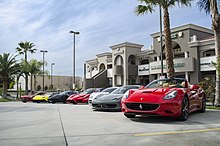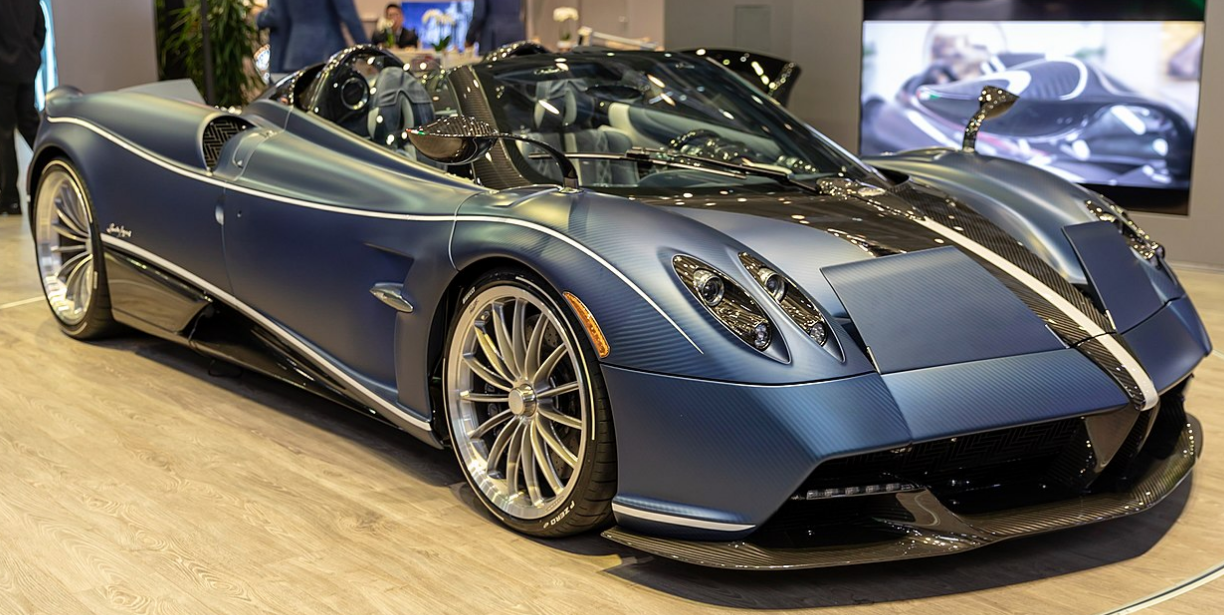Supercars Mercedes SLS AMG, Lamborghini Aventador, Pagani Huayra, Ferrari Enzo, Bugatti Veyron, Ferrari 458 Italia, and Ferrari California.

Supercar

For the Australian motor racing series, see Supercars Championship. For other uses, see Supercar (disambiguation), Hypercar (disambiguation), Supercar (TV series), and Muscle car.
Not to be confused with grand tourer.


A supercar – also called exotic car – is loosely defined or described as a street-legal, superlative performance sports car – both in terms of power, speed, and handling. The term ‘supercar’ is therefore frequently used for low-bodied sportscars with powerful, rear mid-mounted engines.[1] Since the 2000s, the term hypercar has also come into use for the most high-end performance cars.

Supercars commonly serve as the flagship model within a vehicle manufacturer’s line-up of sports cars and typically feature various performance-related technology derived from motorsports. Some examples include the Ferrari 458 Italia, Lamborghini Aventador, and McLaren 720S. By contrast, automotive journalism typically reserves the predicate ‘hypercar’ for (very) limited, (two- to low 4-figure) production-number cars, with new-prices in the 21st century often exceeding a million Euros, dollars or pounds. Contrary to the “regular” range-topping supercars, many hypercars are more rare, even in an exotic car maker’s history – appearing as one-offs, like Porsche’s Carrera GT, or just occasionally made specialty models, built over and above the marque’s typical product line-up, like the Ford GTs or Ferrari’s F40, F50 and Enzo lineage. Very few car makers, like Bugatti and Koenigsegg, only make hypercars.

In the United States, muscle cars were often referred to as “supercars” during the 1960s.
History

Europe
The Lamborghini Miura, produced from 1966 to 1973, is often said to be the first supercar.[2][3][4][5] By the 1970s and 1980s the term was in regular use, if not precisely defined.[6][7] One interpretation up until the 1990s was to use it for mid-engine two-seat cars with at least eight cylinders (but typically a V12 engine), a power output of at least 400 bhp (298 kW) and a top speed of at least 180 mph (290 km/h).[8] Other interpretations state that “it must be very fast, with sporting handling to match”, “it should be sleek and eye-catching” and its price should be “one in a rarefied atmosphere of its own”[9] or regard exclusivity (i.e. limited production volumes) as an important characteristic (such as those made by Ferrari or Lamborghini).[5] Some European manufacturers specialize in only producing supercars, such as McLaren, Pagani, and Koenigsegg.[10][11][12][13][14]
It is also claimed that the definition of a supercar has always been subjective and a matter of blind prejudice.[8]
United States
See also: Muscle car § Supercars
During the 1960s, cars that are now considered to be muscle cars were then referred to as supercars.[15][16]: 8 The term was sometimes spelled with a capital S.[17] In 1966 the sixties supercar became an official industry trend.[15]: 8 For example, the May 1965 issue of the American magazine Car Life includes multiple references to supercars and “the supercar club”[18] and a 1968 issue of Car & Driver magazine refers to “the Supercar street racer gang” market segment.[19] In the model name of the AMC S/C Rambler, the “S/C” is an abbreviation for “SuperCar”.[20]
Since the decline of the muscle car in the 1970s, the word supercar came to mean a car that has high performance[15]: 5 interpretations of the term are for limited-production models produced by small manufacturers for enthusiasts, and, less so, standard-looking cars modified for increased performance.[21]
The 1990s and 2000s saw a rise in American supercars with similar characteristics to their European counterparts.[22][23] American sports cars which have risen to be referred to by the supercar name include the Chevrolet Corvette, Dodge Viper, and Ford GT.[24][25][26][27][28][29] Smaller American manufacturers have also made supercars, such as the Saleen S7, SSC Ultimate Aero, SSC Tuatara, Hennessey Venom GT, and Hennessey Venom F5.[30][31][32][33][34]
Japan
During the early 1990’s Japan began to gain global recognition for making high-performance sports cars, but the automotive media first recognized the Honda NSX produced from 1990 to 2005 as Japan’s first supercar, with its lightweight mid-engined, rear-wheel-drive layout.[35][36][37] The NSX was praised for being more reliable and user-friendly than contemporary European supercars.[38][39]
In the 21st century, other Japanese brands also decided to make their own supercars. From 2010 to 2012, Lexus produced the Lexus LFA, a two-seat front-engine coupe powered by a 4.8 L (293 cu in) V10 engine producing 553 hp (412 kW; 561 PS).[40][41][42] The 2009–present Nissan GT-R has also been praised as a modern supercar with every day practicality.[43][44][45] It features a twin-turbo V6 producing between 473–710 hp (353–529 kW; 480–720 PS), and has been lauded for its acceleration and handling through its all-wheel-drive drivetrain and dual-clutch transmission.[46][47][48][49]
The second generation of the Honda NSX from 2016 to 2022 marked a change in approach for Honda, by using all-wheel drive, a hybrid powertrain producing up to 602 hp (449 kW; 610 PS), turbocharging and a dual-clutch transmission, elevating the NSX marque to contemporary supercar standards.[50][51][52]
Hypercar
A more recent term for high-performance sportscars is “hypercar”, which is sometimes used to describe the highest performing supercars.[53] As per supercars, there is no set definition for what constitutes a hypercar. An attempt to define these is “a limited-production, top-of-the-line supercar with a price of around or more than US$1 million.”[54]
Some people consider the 1993 McLaren F1 to be the first hypercar,[55] while others believe the 2005 Bugatti Veyron was the first hypercar.[56]
With a recent shift towards electrification, many recent hypercars use a hybrid drivetrain, a trend started in 2013 by the McLaren P1, Porsche 918 Spyder, and LaFerrari, then continued in 2016 with the Koenigsegg Regera, in 2017 with the Mercedes-AMG One, and the McLaren Speedtail.[57][58][59]
Modern hypercars such as Pininfarina Battista, NIO EP9, Rimac Nevera, and Lotus Evija have also gone full-electric.
Hypercars have also been used as a base for the Le Mans Hypercar class after rule changes come into effect from 2021.[60]









